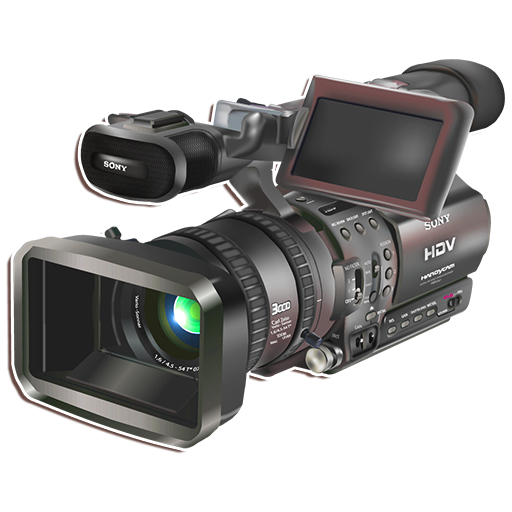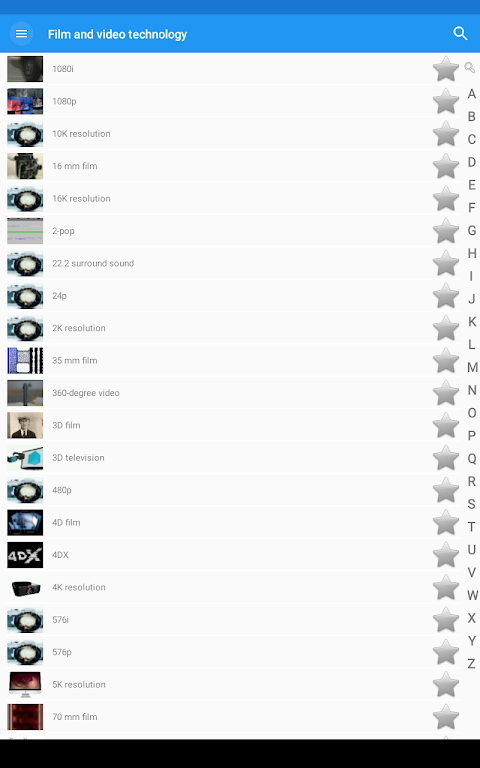Film and video technology
The free application "Film and video technology" is very friendly, it has a beautiful and simple interface. The best choice for a pocket dictionary that is always at hand. From which you can learn a lot of new and interesting things, for example, that:
Display Serial Interface
The Display Serial Interface (DSI) is a specification by the Mobile Industry Processor Interface (MIPI) Alliance aimed at reducing the cost of display controllers in a mobile device. It is commonly targeted at LCD and similar display technologies. It defines a serial bus and a communication protocol between the host and the device.
Nebula Electronics
For the Romanian satellite television provider to South-Eastern Europe named Digi TV, see Digi TV.
PAL region
The PAL region is a television publication territory that covers most of Asia, Africa, Europe, South America and Oceania. It is so named because of the PAL television standard traditionally used in those regions, as opposed to the NTSC standard traditionally used in Japan and nearly all of North America.
Features
:
• The dictionary works offline - you do not need an internet connection. Access to articles (descriptions) offline, without an Internet connection (except for photographs);
• Very quick search for descriptions. Equipped with a quick dynamic search function - the dictionary will start searching for words during input;
• Unlimited number of notes (favorites);
• Bookmark - you can add descriptions to your favorites list by clicking on the asterisk icon;
• Manage bookmark lists - you can edit your bookmark lists or clear them;
• Search History;
• Voice search;
• Compatible with modern versions of Android devices;
• Very efficient, fast and good performance;
• An easy way to share with friends;
• The application is very easy to use, fast and with extensive content;
• Automatic free updates every time new terms are added;
• The directory "Film and video technology" is designed to occupy as little memory as possible.
Features
Premium
:
✓
no ads
;
✓
photos, images of access offline
;
✓
Clear browsing history
.
Content
Film and video technology encompasses a vast and ever-evolving landscape, shaping the way we capture, edit, and experience moving images. From the earliest days of celluloid film to the digital revolution and beyond, this dynamic field has continually pushed the boundaries of artistic expression and technological innovation. This exploration delves into the key aspects of film and video technology, tracing its historical development, examining core principles, and considering the future trajectory of this influential medium.
The genesis of film technology can be traced back to the late 19th century, with pioneers like Étienne-Jules Marey and Thomas Edison developing devices capable of capturing sequential images, creating the illusion of motion. The Lumière brothers further refined these early inventions, showcasing their cinématographe in 1895, marking a pivotal moment in the birth of cinema. Early films were silent, black and white, and limited in duration, yet they captivated audiences and laid the foundation for the narrative storytelling that would define the medium.
The advent of sound in the late 1920s revolutionized filmmaking, adding a new dimension to the cinematic experience. Synchronized soundtracks, incorporating dialogue, music, and sound effects, transformed the way stories were told and perceived. This technological leap propelled the film industry forward, ushering in the "Golden Age of Hollywood" and solidifying film's position as a dominant form of entertainment.
Color film technology, though experimented with in the early 20th century, gained widespread adoption in the mid-20th century, adding vibrancy and realism to the cinematic canvas. Technicolor, a prominent color process, became synonymous with the vibrant hues of classic Hollywood films, further enhancing the immersive quality of the cinematic experience.
The latter half of the 20th century witnessed the emergence of video technology, offering a new and accessible medium for capturing and distributing moving images. Magnetic tape recording allowed for longer recording times and easier editing compared to film, opening up new possibilities for television production and independent filmmaking. The development of video cameras, initially bulky and expensive, gradually became more compact and affordable, democratizing access to moving image creation.
The digital revolution, beginning in the late 20th century, fundamentally transformed film and video technology. Digital cameras, utilizing image sensors instead of film stock, offered increased flexibility, improved image quality, and streamlined workflows. Non-linear editing systems, replacing traditional film editing techniques, provided unprecedented control over the editing process, enabling filmmakers to manipulate and refine their work with greater precision.
The rise of computer-generated imagery (CGI) further expanded the creative possibilities of filmmaking, allowing for the creation of realistic special effects and fantastical worlds previously unimaginable. CGI has become an integral part of contemporary filmmaking, blurring the lines between reality and illusion, and pushing the boundaries of visual storytelling.
The 21st century has witnessed the proliferation of digital distribution platforms, transforming the way films and videos are consumed. Streaming services, online video platforms, and social media have democratized distribution, providing filmmakers with unprecedented access to global audiences. This shift has also led to new forms of storytelling, tailored to the specific characteristics of these digital platforms.
The future of film and video technology promises continued innovation and evolution. Virtual reality (VR) and augmented reality (AR) are emerging as immersive mediums, offering new ways to experience and interact with moving images. Artificial intelligence (AI) is also playing an increasingly important role in filmmaking, automating tasks, enhancing visual effects, and even generating creative content.
The ongoing development of higher resolution formats, such as 8K and beyond, promises to deliver even more detailed and immersive visual experiences. High dynamic range (HDR) imaging, capturing a wider range of light and color, further enhances the realism and visual impact of moving images.
As film and video technology continues to advance, the boundaries of creative expression will continue to expand. From the earliest flickering images to the immersive worlds of VR and AR, the journey of film and video technology is a testament to human ingenuity and the enduring power of visual storytelling. The future of this dynamic field promises to be as exciting and transformative as its rich history, shaping the way we experience and understand the world around us.
Film and video technology
The free application "Film and video technology" is very friendly, it has a beautiful and simple interface. The best choice for a pocket dictionary that is always at hand. From which you can learn a lot of new and interesting things, for example, that:
Display Serial Interface
The Display Serial Interface (DSI) is a specification by the Mobile Industry Processor Interface (MIPI) Alliance aimed at reducing the cost of display controllers in a mobile device. It is commonly targeted at LCD and similar display technologies. It defines a serial bus and a communication protocol between the host and the device.
Nebula Electronics
For the Romanian satellite television provider to South-Eastern Europe named Digi TV, see Digi TV.
PAL region
The PAL region is a television publication territory that covers most of Asia, Africa, Europe, South America and Oceania. It is so named because of the PAL television standard traditionally used in those regions, as opposed to the NTSC standard traditionally used in Japan and nearly all of North America.
Features
:
• The dictionary works offline - you do not need an internet connection. Access to articles (descriptions) offline, without an Internet connection (except for photographs);
• Very quick search for descriptions. Equipped with a quick dynamic search function - the dictionary will start searching for words during input;
• Unlimited number of notes (favorites);
• Bookmark - you can add descriptions to your favorites list by clicking on the asterisk icon;
• Manage bookmark lists - you can edit your bookmark lists or clear them;
• Search History;
• Voice search;
• Compatible with modern versions of Android devices;
• Very efficient, fast and good performance;
• An easy way to share with friends;
• The application is very easy to use, fast and with extensive content;
• Automatic free updates every time new terms are added;
• The directory "Film and video technology" is designed to occupy as little memory as possible.
Features
Premium
:
✓
no ads
;
✓
photos, images of access offline
;
✓
Clear browsing history
.
Content
Film and video technology encompasses a vast and ever-evolving landscape, shaping the way we capture, edit, and experience moving images. From the earliest days of celluloid film to the digital revolution and beyond, this dynamic field has continually pushed the boundaries of artistic expression and technological innovation. This exploration delves into the key aspects of film and video technology, tracing its historical development, examining core principles, and considering the future trajectory of this influential medium.
The genesis of film technology can be traced back to the late 19th century, with pioneers like Étienne-Jules Marey and Thomas Edison developing devices capable of capturing sequential images, creating the illusion of motion. The Lumière brothers further refined these early inventions, showcasing their cinématographe in 1895, marking a pivotal moment in the birth of cinema. Early films were silent, black and white, and limited in duration, yet they captivated audiences and laid the foundation for the narrative storytelling that would define the medium.
The advent of sound in the late 1920s revolutionized filmmaking, adding a new dimension to the cinematic experience. Synchronized soundtracks, incorporating dialogue, music, and sound effects, transformed the way stories were told and perceived. This technological leap propelled the film industry forward, ushering in the "Golden Age of Hollywood" and solidifying film's position as a dominant form of entertainment.
Color film technology, though experimented with in the early 20th century, gained widespread adoption in the mid-20th century, adding vibrancy and realism to the cinematic canvas. Technicolor, a prominent color process, became synonymous with the vibrant hues of classic Hollywood films, further enhancing the immersive quality of the cinematic experience.
The latter half of the 20th century witnessed the emergence of video technology, offering a new and accessible medium for capturing and distributing moving images. Magnetic tape recording allowed for longer recording times and easier editing compared to film, opening up new possibilities for television production and independent filmmaking. The development of video cameras, initially bulky and expensive, gradually became more compact and affordable, democratizing access to moving image creation.
The digital revolution, beginning in the late 20th century, fundamentally transformed film and video technology. Digital cameras, utilizing image sensors instead of film stock, offered increased flexibility, improved image quality, and streamlined workflows. Non-linear editing systems, replacing traditional film editing techniques, provided unprecedented control over the editing process, enabling filmmakers to manipulate and refine their work with greater precision.
The rise of computer-generated imagery (CGI) further expanded the creative possibilities of filmmaking, allowing for the creation of realistic special effects and fantastical worlds previously unimaginable. CGI has become an integral part of contemporary filmmaking, blurring the lines between reality and illusion, and pushing the boundaries of visual storytelling.
The 21st century has witnessed the proliferation of digital distribution platforms, transforming the way films and videos are consumed. Streaming services, online video platforms, and social media have democratized distribution, providing filmmakers with unprecedented access to global audiences. This shift has also led to new forms of storytelling, tailored to the specific characteristics of these digital platforms.
The future of film and video technology promises continued innovation and evolution. Virtual reality (VR) and augmented reality (AR) are emerging as immersive mediums, offering new ways to experience and interact with moving images. Artificial intelligence (AI) is also playing an increasingly important role in filmmaking, automating tasks, enhancing visual effects, and even generating creative content.
The ongoing development of higher resolution formats, such as 8K and beyond, promises to deliver even more detailed and immersive visual experiences. High dynamic range (HDR) imaging, capturing a wider range of light and color, further enhances the realism and visual impact of moving images.
As film and video technology continues to advance, the boundaries of creative expression will continue to expand. From the earliest flickering images to the immersive worlds of VR and AR, the journey of film and video technology is a testament to human ingenuity and the enduring power of visual storytelling. The future of this dynamic field promises to be as exciting and transformative as its rich history, shaping the way we experience and understand the world around us.












